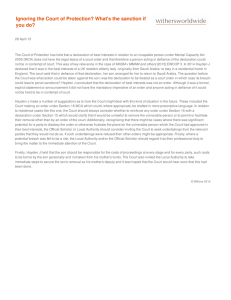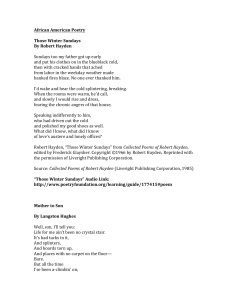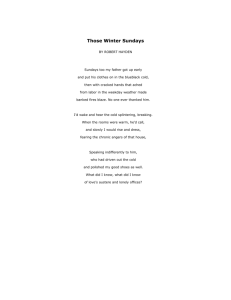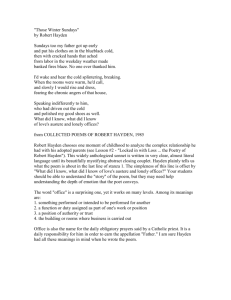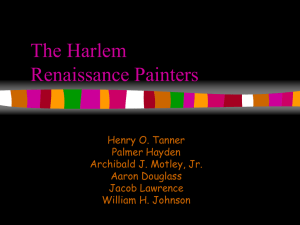Foundations of Torey Hayden's Relationship
advertisement
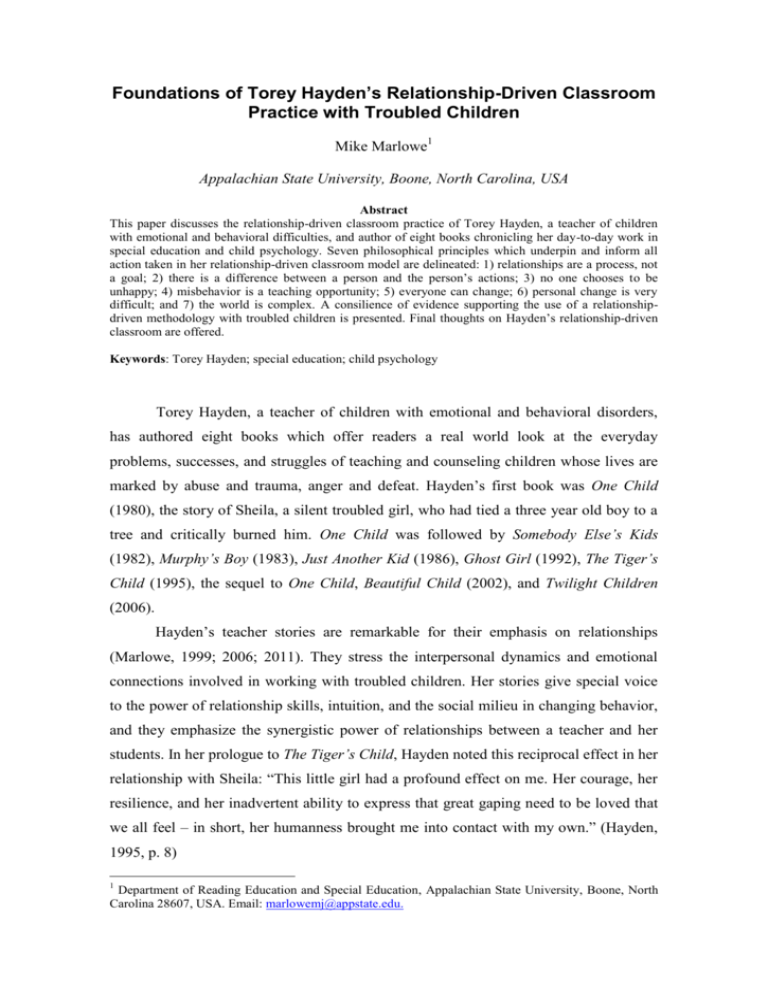
Foundations of Torey Hayden’s Relationship-Driven Classroom
Practice with Troubled Children
Mike Marlowe1
Appalachian State University, Boone, North Carolina, USA
Abstract
This paper discusses the relationship-driven classroom practice of Torey Hayden, a teacher of children
with emotional and behavioral difficulties, and author of eight books chronicling her day-to-day work in
special education and child psychology. Seven philosophical principles which underpin and inform all
action taken in her relationship-driven classroom model are delineated: 1) relationships are a process, not
a goal; 2) there is a difference between a person and the person’s actions; 3) no one chooses to be
unhappy; 4) misbehavior is a teaching opportunity; 5) everyone can change; 6) personal change is very
difficult; and 7) the world is complex. A consilience of evidence supporting the use of a relationshipdriven methodology with troubled children is presented. Final thoughts on Hayden’s relationship-driven
classroom are offered.
Keywords: Torey Hayden; special education; child psychology
Torey Hayden, a teacher of children with emotional and behavioral disorders,
has authored eight books which offer readers a real world look at the everyday
problems, successes, and struggles of teaching and counseling children whose lives are
marked by abuse and trauma, anger and defeat. Hayden’s first book was One Child
(1980), the story of Sheila, a silent troubled girl, who had tied a three year old boy to a
tree and critically burned him. One Child was followed by Somebody Else’s Kids
(1982), Murphy’s Boy (1983), Just Another Kid (1986), Ghost Girl (1992), The Tiger’s
Child (1995), the sequel to One Child, Beautiful Child (2002), and Twilight Children
(2006).
Hayden’s teacher stories are remarkable for their emphasis on relationships
(Marlowe, 1999; 2006; 2011). They stress the interpersonal dynamics and emotional
connections involved in working with troubled children. Her stories give special voice
to the power of relationship skills, intuition, and the social milieu in changing behavior,
and they emphasize the synergistic power of relationships between a teacher and her
students. In her prologue to The Tiger’s Child, Hayden noted this reciprocal effect in her
relationship with Sheila: “This little girl had a profound effect on me. Her courage, her
resilience, and her inadvertent ability to express that great gaping need to be loved that
we all feel – in short, her humanness brought me into contact with my own.” (Hayden,
1995, p. 8)
1
Department of Reading Education and Special Education, Appalachian State University, Boone, North
Carolina 28607, USA. Email: marlowemj@appstate.edu.
Torey Hayden
The Relationship-Driven Classroom
To Hayden, there is no single framework upon which we can hang all
interpretations of human behavior. Any given theory, to her way of thinking, simply
provides one interpretation and, like climbing the proverbial mountain, there are many
other paths one could take
While Hayden is open about the fact that she follows no specific model, I have
distilled from her stories an approach to educating troubled children which I refer to as
relationship-driven (Marlowe, 2011). The crucial foundations of a relationship-driven
classroom are the individual relationships between the teacher and the child and those
among the children and the group or unit relationship. What sets the relationship-driven
methodology apart from other methodologies is its active use of interpersonal
relationships as a medium of change.
I observed that Hayden’s first order of business is to establish a relationship with
the child. Initiating and sustaining a relationship with a child is the only context in
which other interventions can succeed.
The cornerstone of this relationship-driven approach is commitment. It is the
unequivocal commitment of one individual to another that evokes positive change.
Troubled children have to have this type of relationship if they are going to move
forward. They need the esteem that comes only from knowing others care about you,
others value you sufficiently to commit to you. They need to know that while significant
others may have been unable to provide this type of commitment, it does not mean they
are unworthy of it. As Urie Bronfenbrenner (2005) proclaimed, every child needs at
least one special adult who is irrationally crazy about him or her, for only then can they
develop to full potential.
In One Child, Hayden changes Sheila’s behavior by forming a relationship
between them. Sheila changes because it mattered to Hayden that she change. Although
Sheila was able to internalize her changes eventually, in the beginning the change
happened because of the relationship between the two of them, and because Hayden
made it apparent that it was important to her that Sheila change. The desire to be liked is
writ large in human relationships.
95
Marlowe
Underlying Principles of a Relationship Driven Classroom
There are seven philosophical principles that underpin relationships as a means
of change (Hayden & Marlowe, in press). These principles evolved from Hayden’s dayto-day interactions with her children more than they were applied.
Relationships are a process, not a goal
There are two different approaches whether it is working with troubled children
or whether it is towards life in general – goal orientated or process orientated
Both
orientations are a normal part of human behavior. In goal orientation you do what you
do for the ultimate outcome. With a troubled child, for example, you work with him
because you have expectations of making him better and more capable of living a
fulfilling life. You have expectations of an outcome from the time you undertake what
you are doing. Fulfillment comes when you reach the goal.
In process orientation you do what you do for the process of doing it. With a
troubled child you don’t have any expectations of what’s going to happen because you
are not looking at the future. You work with the child because you enjoy the act of
being with the child. This means you focus on the process, the doing of something,
rather than the outcome. Consequences or outcome of the experience may reinforce the
behavior but they are not at the heart of this orientation. Fulfilment comes instead from
awareness and appreciation of having the experience while it is happening.
Relationships are, by their very nature, process oriented. They are ongoing and
now. The relationship-driven model is present oriented because relationships only exist
in the present. Thus in order to use relationships as a way of changing behavior, one
must be oriented to the present process as opposed to towards a future goal. In other
words, the relationship the teacher has with the child now is used to change behavior as
opposed to its being a reward or an outcome of the change. The teacher is working
with the environment, modifying what is happening “right now” by means of
relationship skills, intuition and social milieu, all of which exist only in the present.
Staying in the present, staying in the process helps one accept the child. People
who focus on goals tend to be judgmental. They are judging the child against the final
product, and if you haven’t reached your goal you are seen as wanting. Acceptance is
the ground work of trust. We tend to form relationships with the people we feel accept
96
Torey Hayden
us. We need to communicate to the child that who the child is “right now” is sufficient
for me to want to form a relationship.
Hayden has been able to avoid ‘burn out’ because she is a process-oriented
person as opposed to a goal oriented person. In her experience it is the people who need
to succeed – to see success at the end of what they are doing – who burn out. These are
goal oriented people. They are doing what they are doing for the outcome, and because
the outcome with troubled children is often negligible, they lose their enthusiasm.
Hayden works with children because she thoroughly enjoys the process itself. She loves
the act of being with the children. While she is open to the fact that improvement for her
children is desirable, this is not what guides her work. Her pay-off, her fulfilment in
working with children comes during the time spent together, during the interactions,
during the moment itself (Hayden, February 28, 2001).
There is a difference between the person and the person’s actions
Hayden is unequivocally on the child’s side. This doesn’t mean accepting
everything the child does, but it means making clear that the child him/herself is
acceptable. The difference between the person and the person’s action is another way of
saying it.
Understanding the difference between the person and the person’s actions is also
at the heart of developing a tolerant and nonjudgmental attitude toward children’s
capacity to change. If a child’s actions were as unchangeable as his/her identity, then
there would be little scope for his/her learning new or more adaptive behaviors because
“he/she’ll always do that,” or “he/she won’t change.” Understanding that a person isn’t
his/her actions, regardless of the number of times he/she has engaged in a certain action,
allows us recognize he/she has the capacity for different actions.
It is imperative we actively maintain this optimism regarding the possibility of
change: self-esteem can be rebuilt, motivation can be re-instilled, new lives can take
form as long as there is hope this is possible. As teachers there’s not much point being
in the classroom if we don’t genuinely believe children can change. Likewise, it is
important to instil this hopefulness in the children. Hope builds spiritual strength and
self-efficacy giving the young person the courage to change.
97
Marlowe
No one chooses to be unhappy
Unhappiness makes one feel dismal as attested to when Hayden asked her
students to write about something that made them unhappy One girl wrote, “What
makes me unhappy is going to bed and it will be so cold and so dark. I don’t like to be
there. I’m scared and I cry.” Another child wrote, “Sometimes I wish I was dead. I want
to kill myself. I get so sad. Nobody cares. I almost want to kill myself. I wish I knew
what to do. Nobody likes me and I don’t much either. I just wish I know what to do.”
And another child, “Once I got so unhappy I cried to God. I put a bag on my head and
tied a string around it and I sat in my closet on the closet floor. It didn’t work. I’m still
alive” (Hayden & Marlowe, 2005).
Hayden believes we all want to be happy. Everything we do, no matter how odd
or misguided, is done because we think consciously or unconsciously that it will lead to
our feeling happier. This is simply another way of saying “Everyone is doing the best
they can.” Children engaging in difficult or destructive behaviour do so in erroneous
belief that this will relieve their unhappiness.
unhappy.
They are not actively trying to be
Instead, they are actively trying to be happy but going about it in an
unproductive way, because - for whatever reason – they are simply not able to do
differently at this point in time. A misbehaving child isn’t wilfully choosing to be
unhappy. He/she genuinely hasn’t come up with a more effective way of being happy.
Understanding this concept is important to relationship forming because it helps
us realize that however irksome, stupid, or incomprehensible a child’s behaviour seems
to be, they won’t be doing it just to irritate us. They will be behaving this way because,
for whatever reason, they simply don’t know how to do differently.
Once you arrive at a place of understanding that children do not choose to be
unhappy, you can then surmise that if they continue doing something that repeatedly
makes them unhappy, it is because – for whatever reason – they are simply unable to do
differently at this point in time. So that is when we recognize it is no longer solely their
responsibility but ours as well to sort this problem out, because if a load is too heavy for
a child to carry, others standing around pointing fingers at him will never get it shifted.
Instead, we can help. We can teach him how to shift it. We can encourage him. We can
share the burden until he is strong enough.
98
Torey Hayden
Misbehavior is a teaching opportunity
If everyone wants happiness and no one wants unhappiness. yet there is
misbehavior that results in unhappiness, then Hayden assumes the person does not know
how to do differently. If he/she did, he/she would be doing it, because unhappiness is
generally displeasing.
If, on the other hand, someone doesn’t know how to do
differently, then the appropriate response from those who do is to teach him or her how.
Most children in programs for emotional and behavioural disorders will have
considerable familiarity with dysfunctional adults and dysfunctional relationships. In
contrast, they will have little experience of functional adults relating appropriately.
Hayden posits it is thus both unrealistic and unreasonable to expect children to
disengage from difficult cycles of behavior on their own without first gaining
experience of the functional behaviors they need to emulate. In a relationship-driven
methodology, functional behavior is taught actively via the teacher-child relationship in
order to give children experience of the appropriate behaviors they are expected to use.
Some aspects of appropriate behavior are taught by the teacher through active modelling
and others are taught to the child directly, such as how a functional person manages
his/her emotions, how a functional person relates appropriately to others, and how a
functional person handles negative situations.
Hayden cautioned an audience of teachers to always remember you are a teacher
(Hayden and Marlowe 2005). Tackle misbehaviour from the perspective of a teacher.
That means you need to teach appropriate behaviour. Don’t approach behaviour from
the perspective that it needs to be punished. Punishment can cause students to resent
their teachers and even rebel against them. In the relationship-driven classroom the first
line of intervention is not punishment but teaching appropriate behaviour.
To elaborate, an example of a child who misbehaves because he/she does not
know how to behave differently was One Child’s six-year-old Sheila whose life was a
pornographic tale. Sheila was often very rude with the other children. She had never
been taught how to be kind or polite or considerate of others. When someone got the
place in line she had chosen, she socked that person hard enough to win it back. If
another child had a toy she wanted, she grabbed it, wrestled it out of the child’s hand,
and scuttled off to safety with it to hiss angrily at anyone who tried to take it away. The
99
Marlowe
natural consequence of this was that other children didn’t like her very well and didn’t
want to play with her.
To punish her for not being polite, for not obeying rules would have been a bad
decision on the part of Hayden. It was more efficient to regard Sheila’s behaviour as a
teaching opportunity. She didn’t actually know how to be polite (didn’t know how to
behave differently.) “Please” and “thank you” were not used regularly in her home
environment and she had not been actively taught social skills by the adults around her.
Role play and direct teaching were used (“When you want something, you say, “Please
may I have it,” and if they give it to you, you say, “Thank you.”) and when she forgot,
she was reminded. Natural consequences in the form of the other children responding
more positively to her efforts to be polite reinforced this teaching.
So discipline in a relationship-driven classroom can be summed up as: never
pass up an opportunity to teach. Being a teacher overarches every other aspect of what
you do. You are not a prison warden. You are a teacher. This means you want to
approach every situation in the classroom with a mind open to teaching opportunities,
because this is what you are there to do.
Everyone can change
Hayden believes that everyone regardless of who they are and what they have
done, can change. This belief is the foundation upon which all the rest of the
relationship-driven model is built.
Everybody can change is just a practical attitude. Pollyanna says, “Everyone will
change.” This statement is just as black-and-white as “He’ll never change.” What
Hayden wants to cultivate is the ability to stay positive about the possibility of change,
and the recognition that we are not omniscient. It’s easy to fall into using black-andwhite terms like "always" or "never" in regards to difficult behavior, but in doing so we
are implying that the children and situations we are dealing with are fixed, and discreet,
and therefore entirely predictable, when they are, in fact, constantly changing and
connected to and affected by an infinite number of other things that we have no
knowledge of, insight into, or control over.
To claim someone is unable to change is to take the 100% nature stance that says
we are little different from flatworms or amoeba – just a product of our circumstances –
and nothing we can do to change that. To state that a child “is bad through and through
100
Torey Hayden
and can never change” is simply an excuse for excluding someone or for not getting
involved and avoiding taking any responsibility for the problem yourself.
Hayden believes because we may not be able to see how change will take place
doesn’t mean there is no chance for change. We need to promote personal change as
doable, and in the process, distinguish in our own minds the difference between "I can't
do any more to help this child," and "No one can can help this child."
Personal change is very difficult
In Hayden’s experience changing ingrained personal behavior is very hard to do.
There are many reasons for this: genetic make-up, environmental circumstances,
motivation, and consequences all factor in. As a result, it is normal for the individual
who is trying to change to make many approximations before managing the right
behaviour. It is also normal to slip up or fail many times before eventually achieving
the behavior.
Understanding this is important to tolerance and acceptance of others because it
is normal human nature to want things quickly whereas in the real world it is normal to
backslide, for there to slips, misses and even total failures. A tolerant teacher
understands that this does not mean that change is not taking place or that change is
impossible. It simply means the child hasn’t got there yet.
It is normal for the increments of change to be very, very small and the more
entrenched the behavior, the smaller they usually have to be for success to be
maintained. Because of this, it is necessary and, indeed, crucial to reward
approximations of the desired behavior as one goes along. It is also important for both
teacher and child to be aware from the onset that it is entirely normal to have to make
such small steps and that the person making the change should be encouraged to be
positive about any movement in the right direction, however minute the increments.
Change can be slow, subtle, and difficult and very often happens in a manner
much different to what we had planned or envisioned, so it is important children be
aware of this and be aware this is normal. We want to help children shift away from the
goal oriented judgment perspective that “I tried. I failed. I can’t do it. I give up,” to the
process-oriented “I tried. It didn’t happen this time. I’ll try again.”
101
Marlowe
The world is complex
Hayden has pointed out many places that black-and-white thinking - the
tendency to perceive things as all-or-nothing and thus able to be put into discernible,
discreet and permanent categories – seems to be a hard-wired trait for humans. We
categorize and generalize by nature.
From the perspective of a relationship-driven approach, there are three
important reasons for avoiding black-and-white thinking. One, almost all behaviors are
on a spectrum and not at the two (black or white) extremes. For example, we are
virtually never entirely happy or entirely sad. Happy is one end of the spectrum, sad is
at the opposite end and we normally tend to fall somewhere in between. Recognizing
the spectrum nature of behavior makes it much easier to accept approximations of
appropriate behavior and to see positive movement towards the wanted behavior
because we can see what is being done is further up the spectrum than the previous
behavior. In contrast, black-and-white thinking allows us only two outcomes: success
or failure.
Two, black-and-white thinking tends to ignore time and the fact that all things
change over time. We are not at all static creatures. We are never really the same
twice.
Recognizing this continual process of change allows us to recognize the
potential for things to be different than they are right now. In contrast, black-and-white
thinking assumes permanence and looks for opportunities to reinforce that. The blackand-white thinker looks only for evidence that reinforces categorization and ignores
evidence of change. Once a bully, always a bully, for example.
And three, black-and-white rules have the potential for creating power
struggles. Difficult, defiant children often react to black-and-white rules rather as if the
teacher had drawn the proverbial line in the sand and said, “Don’t cross this.” The child
just has to break the rule to show he can. This puts the teacher into the difficult position
of either having to escalate to confrontation or risk losing either authority or consistency
by ignoring the rule breaker. This is an undesirable situation because the teacher is
being forced to react to the student rather than respond, and this is never a position of
strength. So it works better if the rules are flexible enough to allow for face saving
behaviour and reasonable amounts of testing behaviour to be ignored, when this is
situationally appropriate.
102
Torey Hayden
In the One Child classroom Hayden kept her rules open-ended. She basically
only had two rules. The first one being “Do your best.” Most children do have a sense
of when they are trying hard - and yet it allows both the teacher and the child some
wiggle room in interpreting and applying the rule. If you have a child who comes in
very tired from having a very horrible night at home with his family, doing his best that
day may be different from doing his best another day. Open-ended rules allow you to
accommodate more easily. The second rule, “ You are not allowed to hurt people,
animals or things that belong to others or are for everyone to use,” is more specific, but
it still allows for flexible interpretations in instances of accidental behaviour and in
terms of what constitutes “things for everyone to use.”
So it is important when working with a relationship-based methodology that one
have a clear understanding that the world is complex, that we can’t reduce it to clearcut, comprehensible certainties. This kind of open-ended acceptance is one of the most
crucial attributes for success in the dynamic realm of relationships.
The Test for Truth
The gold standard for truth is that an idea from one field fits with ideas drawn
from other realms of experience (Brendtro, Mitchell, & McCall, 2009). This is called
consilience by philosophers of science (Wilson, 1998). Consilience links findings from
separate fields to discover simpler universal principles. Consilience requires that truth
be tested against the multiple perspectives of science, experience, and universal human
values.
Hayden’s relationship-driven classroom approach to teaching troubled youth
meets the test of consilience. It is supported by knowledge from (1) biological science,
(2) social science, (3) practice expertise, (4) the voices of youth and their families, and
(5) universal values of respect and human dignity.
To begin, biological science reveals that the brains of children have inbuilt
attachment programs which strongly motivate them to seek out positive bonds with
caring adults (Cozolino, 2006). The need for belonging permeates all of our
relationships; it is designed into our DNA (Salavitz & Perry, 2010).
Two, social science research in both teaching and therapy shows the power of
interpersonal relationships. Teachers of children with emotional and behavioral
disorders with varied teaching styles can be successful if they develop positive
103
Marlowe
relationships with their students (Morse, 2008). Likewise, a common element within all
forms of effective psychotherapy and counseling is a respectful, valuing, and empathetic
bond between therapist and client (Hubble, Duncan, & Miller, 1999). Psychiatrists and
psychologists call such a relationship between the therapist and client the therapeutic
alliance. A similar bond – a pedagogical alliance – between teacher and student is
similarly powerful when teaching students with emotional and behavioral disorders
(Danforth & Smith, 2005).
Three, practice expertise from the successful experiences and the collective
wisdom of youth care work pioneers demonstrates the power of human relationships.
The hallmark action research of Fritz Redl and David Wineman and Nicholas Hobbs
and William Morse, early leaders in the education of children with emotional
disturbances, shows that real behavior change is facilitated by relationships. Nicholas
Long (2008), co-author of six editions of Conflict in the Classroom with Morse states
that “if we are not successful in developing interpersonal bonds with youth, then all
subsequent treatment and pedagogical techniques are mechanical. It is like racing a car
engine without any oil. It is not going very far before it heats up and shuts down” (p.
57).
Four, experience includes not only practice expertise but also the often ignored
first-hand knowledge from youth and their families. Werner and Smith (1989) studied
Hawaiian children with multiple risk factors (poverty, strained parental relationships,
and poor role models) for 40 years. They found that one out of three of these children
developed into competent adults. They then studied the children who were able to
succeed despite living with much stress and adversity and identified factors that were
present in these successful children; these factors form the basis of resilience. Werner
and Smith found, among other things, that these children often credited a favorite
teacher who went beyond academics and became a mentor, confidant, and positive role
model for personal identification. Likewise, a national survey of 12,118 adolescents by
Resnick et al. (1997), titled “Protecting Adolescents from Harm,” found having an adult
who was supportive to them was the strongest protective factor. The adult was someone
the youth could count on for understanding, advice, and support. Teachers were among
those adults mentioned most frequently as the source of this support. Families of
troubled youngsters also consistently report that what is significant about programs was
that workers made them feel like they were important, like they cared (Garfat, 2010).
104
Torey Hayden
And five, values of human dignity motivate us to create caring environments
where all young persons are treated with respect (Seita, Mitchell, & Tobin, 1996).
Humans are innately disposed to treat others the way they want to be treated. This is the
golden rule which is universal across all major religions.
Final Thoughts on Hayden’s Relationship-Driven Classroom Practice
In setting up a relationship-driven classroom Hayden relies “fairly heavily on
personal charisma” (Hayden, 1988, p. 221).
Her intensely up close and personal
approach tended to be effective with children, and yet it could be very hard if the school
year end came before the child was ready.
Hayden has developed a philosophy of attachment and loss in forming
relationships which threads through her books. For her forming relationships is central
to teaching, but it inevitably implies eventual loss, just the way birth inevitably contains
within it the guarantee of eventual death. One of her favorite quotes is: “A ship in the
harbor is safe, but that’s not what ships were built for.” In other words, the only certain
way to stay safe from loss is never having attachment, but research in psychology and
sociobiology shows that we are a social species and are primed biologically to have
relationships from birth. That Hayden formed attachments which she knew ultimately
would end simply meant she was able to keep an objective eye on what was going on in
her teacher-student relationships - I’m a teacher; my ending comes in June – not that she
was any better at loss than her students or that it hurt her any less. Part of what she
teaches in forming an attachment, is how to cope with loss, and loss comes to all of us.
Hayden’s goal in forming relationships with her children as stated various times
through her books is to help more than she hurts. She states that’s all any of us can aim
for, as the perfect person or perfect relationship does not exist. She remains committed
to the idea that we all do need to know in a very real way that we matter to someone,
someplace, even if we cannot be together. “And real love, for whatever time it lasts, is
never wasted” (Hayden, August 31, 2001).
References
Brendtro, L.K., Mitchell, M.L, & McCall, H.J. (2009). Deep brain learning: Pathways
to potential with challenging youth. Albion, MI: Starr Commonwealth.
105
Marlowe
Bronfenbrenner, U. (Ed.). (2005). Making human beings human: Bioecological
perspectives on human development. Thousand Oaks, CA: Sage Publications.
Cozolino, L. (2006). The neuroscience of human relationships: Attachment and the
developing social brain. New York: W.W. Norton and Company.
Danforth, S., & Smith, T.J. (2005). Engaging troubling students: A constructivist
approach. Thousand Oaks, CA: Corwin Press.
Garfat, T. (2010). The truth in their experience. The evidence from youth and families.
Reclaiming Children and Youth, 19, 55-57.
Hayden, T.L. (1980). One child. New York: Avon Press.
Hayden, T.L. (1982). Somebody else’s kids. New York: Avon Press.
Hayden, T.L. (1983). Murphy’s boy. New York: Avon Press.
Hayden, T.L. (1986). Just another kid. New York: Avon Press.
Hayden, T.L. (1992). Ghost girl. New York: Avon Press.
Hayden, T.L. (1995). The tiger’s child. New York: Avon Press.
Hayden, T.L. (2001, February 28). Goal or process oriented? Message retrieved from
http://www.torey-hayden.com/Message board/Our archives/About the books/Somebody
else’s kids.
Hayden, T.L. (2001, August 31). Attachment and loss. Message retrieved from
http://www.torey-hayden.com/Message board/Our archives/Psychology and psychiatry
issues.
Hayden, T.L. (2002). Beautiful child. New York: Avon Press.
Hayden, T.L. (2006). Twilight children. New York: Avon Press.
Hayden, T.L. (Producer) & Marlowe, M. (Director). (2005). Relationship-driven
classroom management. {DVD}. Boone, NC: Department of Reading Education and
Special Education, Appalachian State University.
Hayden, T.L. & Marlowe, M. (in press). Teaching children who are hard to reach:
Relationship-driven classroom practice. Thousand Oaks, CA: Corwin.
Hubble, M., Brandon, B., & Miller, S. (1999). The heart and soul of change.
Washington, DC: American Psychological Association.
Long, N.J. (2008). Breaking the trust barrier with troubled students. Reclaiming
Children and Youth, 17 57-58.
Marlowe, M. (1999). Reaching reluctant students: Insights from Torey Hayden.
Reclaiming Children and Youth, 7, 242-245, 254.
106
Torey Hayden
Marlowe, M. (2006). Torey Hayden’s teacher lore: A pedagogy of caring. Journal of
Education for Teaching: International Research and Pedagogy, 32, 93-103.
Marlowe, M. (2011). The relationship-driven classroom: The stories of Torey Hayden.
Reclaiming Children and Youth, 20, 24-29.
Morse, W.C. (2008). Connecting with kids in conflict: A life space legacy. Sioux Falls,
SD: Reclaiming Children and Youth and Starr Commonwealth.
Resnick, M., Bearman, P., Blum, R., Bauman, K., Harris, K., Jones, R., et al. (1997).
Protecting adolescents from harm: Findings from the national longitudinal study
on adolescent health. Journal of the American Medical Association, 278, 823832.
Salavitz, M., & Perry, B.D. (2010). Born for love. New York: Harper Collins.
Seita, J., Mitchell, M., & Tobin, C. (1996). In whose best interest? Elizabethtown, PA:
Continental Press.
Werner, E., & Smith, R. (1989). Vulnerable but invincible: A longitudinal study of
resilient children and youth. New York: Adams, Bannister, & Cox.
Wilson, E. (1998). Consilience: The unity of knowledge. New York: Alfred A. Knopf.
Received: October 12th, 2011
Accepted: June 4th, 2012
107

